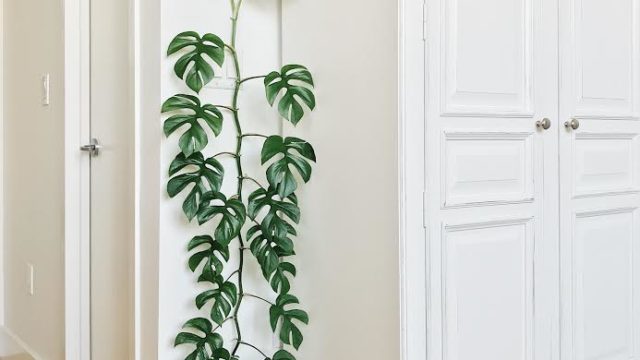
Meet the newest indoor plant with the least verbally-friendly name, Rhaphidophora tetrasperma. They’re super easy plants that look amazing, grow like a weed and are perfect for filling that new year I-need-a-new-Monstera void.

However I’m going to be the bearer of bad news and tell you Rhaphidophora tetrasperma are incorrectly dubbed a “monstera,” when these little plants are not related to Monsteras at all. Yes, they have the Monstera characteristics we all love: the leaf splits, aerial roots, and teenager-like growth – but we all need to accept Rhaphidophora tetrasperma is not a Monstera.
Anyway, I’ve become quite obsessed with these plants and am surprised to see Rhaphidophora tetrasperma care guides to be a bit scarce on the interwebs. So, I decided to make one. As we speak, my Rhaphidophora tetrasperma is coming in the mail, so really I feel like I’m doing this care guide for myself and I’m not ashamed to say that. Anyway, if you find yourself deeply yearning for this plant, read on for an easy guide to keep your Rhaphidophora tetrasperma thriving.
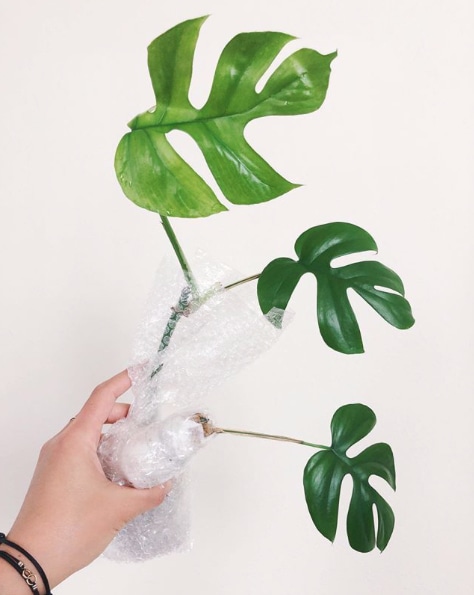
What is a Rhaphidophora tetrasperma?
This is what Rhaphidophora tetrasperma are not: Monsteras. Nor are they Philodendrons. Rhaphidophora tetrasperma are typically called mini Monsteras, Monstera ginny, climbing Monstera, and Split leaf philodendrons. These are all wrong, unfortunately, so let’s all stop incorrectly naming these plants. We all know the real reason is because their actual scientific name is long and awful looking. Rhaphidophora tetrasperma? Geez.
Which brings me to: how do you pronounce Rhaphidophora tetrasperma? If you’re like me, you avoid the name because it’s long and most likely going to be botched. But fear not! It’s actually not that bad: Rah-fid-doe-FOR-AH Teh-trah-SPERM-ma. Ok, it’s still pretty awful.
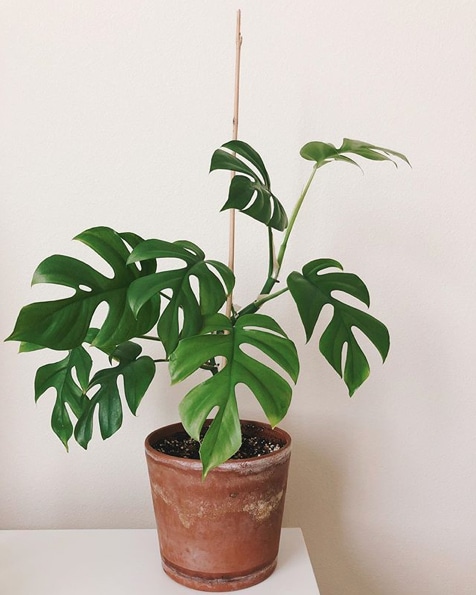
Rhaphidophora tetrasperma are part of the Araceae family but are a genus all their own called Rhaphidophora. They aren’t strictly jungle houseplants either, they can live in dry climates or rainforests making them a pretty low-key houseplant. They’re aroids which means they’re grabby growers and will benefit from a trellis or moss pole to grow alongside them.
Are Rhaphidophora tetrasperma safe for pets?
Because they’re part of the Araceae family (which is home to Monsteras and philodendrons conveniently) these guys contain calcium oxylate crystals which are toxic to dogs and cats. These crystals can lead to internal damage like stomach pain and lethargy and external pain such as mouth stinging. Like all other Araceae plants, keep these out of reach of pets. And remember, because Rhaphidophora tetrasperma are trailers, be aware of them “hanging” where pets can grab, snack on, and pillage them.
Basic Care
Ok, ok, care is like a Monstera, so if you have a Monstera deliciosa, you’re in luck, but I want to remind you these aren’t Monsteras.
Light: Keep out of direct hot sun. Rhaphidophora tetrasperma prefer diffused bright light, such as a few feet from an east or west window. Too much harsh sun can turn the leaves yellow.
Watering: This depends on how bright sunlight levels are, but you can let these dry out a bit. They’re avid growers but I wouldn’t go any more than once a week in winter and a few times a week in summer depending on how warm their environment is. I always recommend a moister meter.
Soil Mix: Go for a chunky soil blend, nothing peaty or overly water-holding. I suggest 50% indoor plant soil and the rest equal parts perlite, orchid bark, small stones and charcoal. You want an airy mix that drains well.
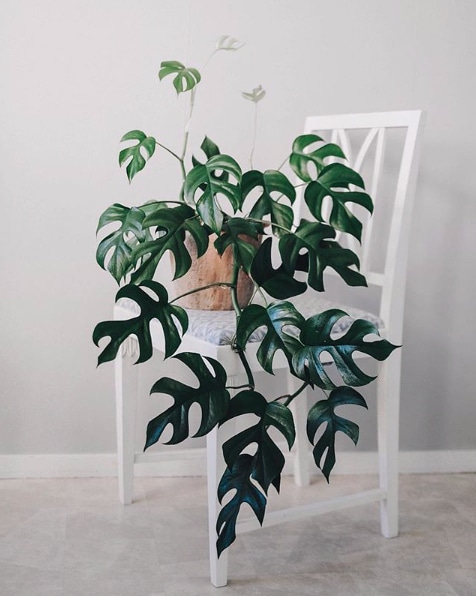
Where can you find one?
Always try your local garden center first, but if that fails you can usually find them on: Amazon, Ken’s Philodendrons, Steve’s Leaves, Pistils Nursery, eBay and Etsy all have cuttings in the $40-50 range.
Rhaphidophora Tetrasperma Problems
While this plant is pretty hands-off, there can be problems. Here’s some basic troubleshooting when you sense some unhappiness or sadness from your long-named friend.
- Yellowing leaves: Too much sun or overwatering. If the plant is too close to the window, it can cause chlorophyll loss. If this isn’t it, it’s mostly likely overwatering. Be sure to only water when the soil is 80% dry and avoid soggy bottoms and drafts.
- No fenestrations: Fenestrations, or the slits in the leaves, are the best part of these plants, I know. Young plants may not have splits and that’s ok! As the plants gets older, the leaves will begin to split; providing ample sunlight and love speeds this process along, too.
- Metallic streaked or ruined leaves: Either spider mites (you’ll see webbing on the underside of leaves) or small black thrips (which leave a metallic sheen on the leaves). Rhaphidophora Tetrasperma leaves are thin, so you want to check for bugs weekly and apply an insecticide at the first signs.

Rhaphidophora Tetrasperma Propagation
All of those visible yummy nodes on Rhaphidophora tetraspermas can become new plants! Because these guys grow quick, you may want to trim them regularly to keep the plant from looking leggy. You can follow my Monstera propagation guide here, as these can be propagated in the same way – cut a chunk of the plant with a leaf or two and a node. Place the node in water or wrap some moist sphagnum moss around it and watch the roots form! It should sprout roots within a few weeks and be ready to plant in a few months.
L&P provides affiliate links in this post. We gain a small commission when you buy something so we can keep creating content!

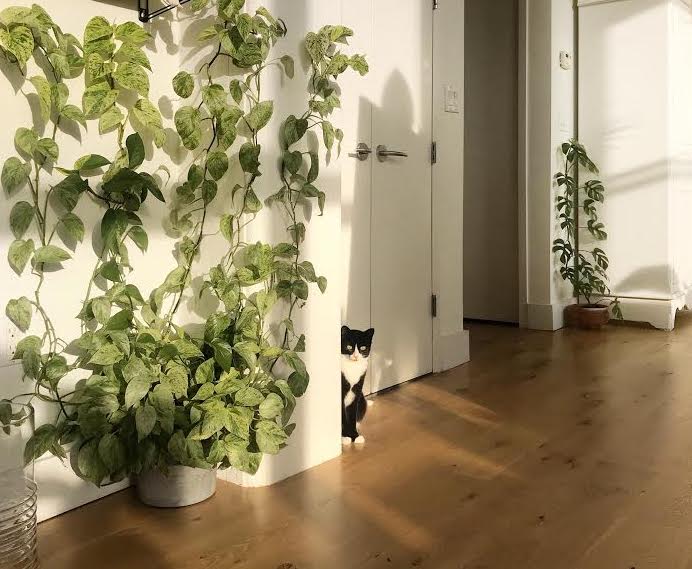
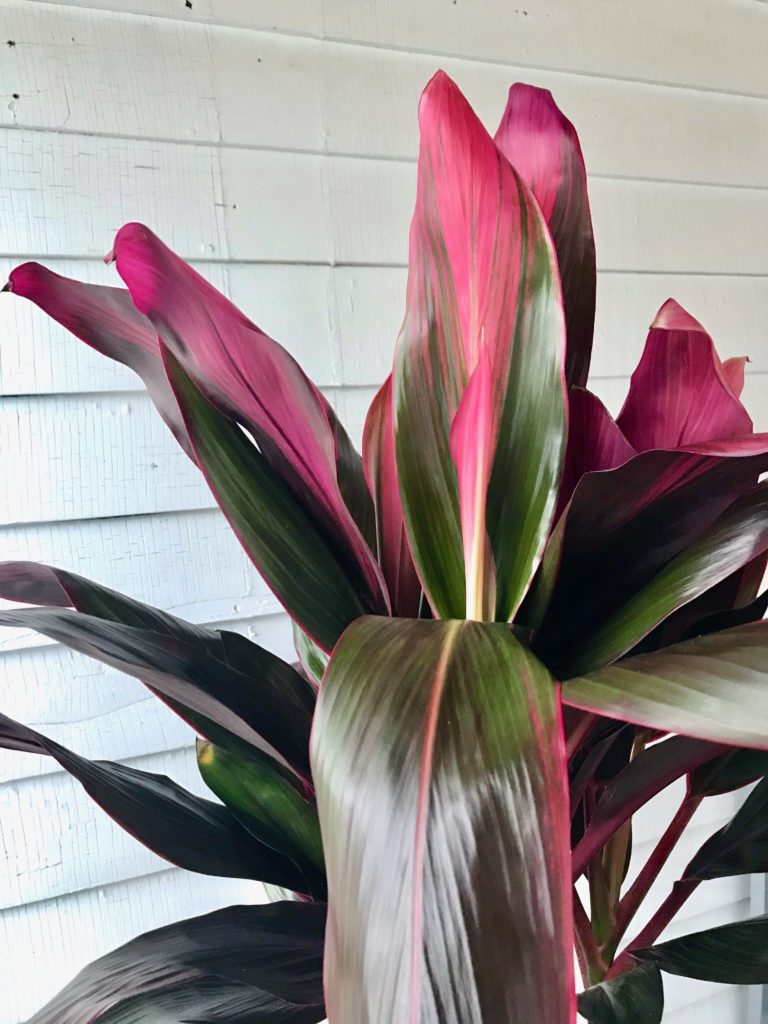
Hi, would like your advise on droopy leaf and some leave curl down inwards. I do have growth. The leave is also bit light in green. Not sure if it’s over water or less water or to hot. https://photos.app.goo.gl/DwwueWxi2dbG5KH19 hope this image can help.
Hi! Possibly both. Very hot temps will do this no doubt, but improper watering (such as watering too little or not “soaking” the plant enough when you do water) is probably the culprit. Be sure to water it thoroughly once a week, possibly more if it’s in a warm environment. They key is to not water in small amounts. Good luck!
Hi Leaf and Paw,
I just bought this plant and want to keep it in my room, however I fear that the light in my room isn’t sufficient enough for this plants growth. I think the spot I currently have this plant in is medium, indirect light. I have a grow light, and was wondering if this along with the medium, indirect light will be enough light to keep the plant healthy? Or should I move it into a better location with brighter natural indirect light?
Hi Tiana, It’s not the best – these guys do really need sufficient light but the grow light may be enough. I always tell people to be careful watering (as in don’t overwater) if they are keeping their plants in lower light rooms. I would say try him in your room and see how he responds.
Is the first picture yours? Did you nailed the plant to the wall? How?
xx Sterre
Hi Sterre, that one is Alina’s plant (link to her IG is in the post) but she uses Command hooks (like this: https://amzn.to/2YNqGtQ) to guide the vines up the wall, no nailing needed.
Hi! Just ordered my first one. Is there a type of planter that is best? Can it hang down? Or should it climb
Hi! I have mine in a ceramic planter (with drainage) that’s sturdy so it can hold a moss pole once it starts to grow more. It can hang or climb, whatever you prefer. I think they look cooler climbing, personally.
Hi! Just ordered my first one. Is there a type of planter that is best? Can it hang down? Or should it climb
I’m wondering why the last 3 leaves on mine are smaller and not fenestrated…?
Thanks for such a good article! I’m more confident that I could take good care of one of these beauties. I’m going to save up for one. They are expensive for me but I really want one!
I just got my first one about a month ago and made a little moss pole for him to climb. It’s under 12″ tall in a 6″ pot. So far I haven’t seen any new leaves and a couple of yellowing leaves at the bottom. I’m guessing this could be overwatering? I’ve been checking the soil moisture each time before watering. Should I expect to see new leaves come from the top?
Hi Rachel, Yes you should see new leaves. RT’s are fast growers, usually pumping out leaves right after another if they’re happy. Yellow leaves are an indicator that you may be overwatering and he is not receiving enough sun. Try only watering when he’s very dry and making sure he’s in bright sun. You should see an improvement soon!
I am so afraid I’m going to kill this plant! The leaves are so fragile, and I’ve torn a few. I have three thick branches in a plastic pot without drain holes (mistake #1), and I think I have overwatered (mistake #2). Some leaf tips are brown and crispy too (mistake #3). She is currently about 5 feet from a due east facing window. Help me please! Should I repot in a terracotta pot with fresh soil? I’d like to avoid root rot. Oh…I’ve had her about 3 weeks.
Hi Deb, don’t be worried, RT’s are pretty durable. But yes, first off, these need well draining soil, so repot in a planter with drainage and a 1/2 soil 1/2 perlite mix (I have the soil and perlite I like here). Next you may want a moisture meter to help you with watering – these guys prefer to be dry rather than overly wet. And last you may want to get a moss pole or something they can climb, it will yield better leaves and they just enjoy something to grab. With these change you should be fine – good luck!
Hi! I have a lovely Rhaphidophora that’s growing like a weed. My apartment has loads of light but not much direct sunlight, so a great place for many types of plants. I’d love to propagate My rhaphidophora, but it only has one branch. If I take a cutting from the top, will it still continue to grow?
Thanks!
Hi Emilie, yes it will and it should make it look fuller. Before you cut, I would make sure the main plant has a moss pole of something to grab onto. Cutting the top will make it top heavy and uneven, so a moss pole provides something for them to grab onto.
My plant looks like the pic above. It is growing in a straight line. If I clip the top, we it branch off into two separate branches?
Yes it will! If chopped it will grow multiple branches from the cut spot.
First off, my plant is growing great but it has developed transparent splotches. It is in my room and due to the fact I sleep with my ceiling fan on high and window cracked is it possible it is getting too cold??
Hi Lorie, Yup, that’s what cold damage looks like. I would take off the affected leaves and definitely move to a place without drafts.
Hi,
I brought a rhaphidophora in May ,2020.after that I noticed one by one yellow leaf from the top of the plant..my apartment has low sun light.fone with the repoting also ..still.i am worried if the plant is dying or what .. please help me to figure out .. already I lost 4-5 leafs
Hi Shilpa, It’s 99% overwatering and a lack of light. At this rate there’s a high risk of killing the plant so you want to find a location with decent light and only water these when they are very dry. You shouldn’t have to water more than once a week even in high light. All plants die slowly and do poorly in low light, so be sure it’s seeing at least 4+ hours of bright light a day.
Hi! I found you by googling. Thanks for the blog post. My awesome friend just gave me this as a cutting from her plant. A root just popped out & im eagerly waiting for more root before potting. I really appreciate all of your tips, & info. Especially the name. Haha.
~Crystal
Hi! I successfully propogated a few of my leaves and replanted them into soil after lots of roots formed. It’s been about 2 weeks and the leaves are starting to form yellow spots (as if they are losing chlorophyll). It is in the same are where the mother plant is which that one is doing great. I checked for spider mites and didn’t see any webbing. Is this a sign of overwatering? The whole leaf isn’t yellowing just spots from the center out.
Thanks so much!
Hmm, it’s hard to tell without seeing it, but it sounds like scale. Scale insects suck the chlorophyl from leaves and leave little yellow circles. If it was overwatering, the leaf would be turning yellow, not just spots. Definitely check for pests, any webbing or black bugs – cuttings are especially susceptible to pests. If you see any little brown bumps, that’s scale and a simple insecticide takes care of them easily.
Hey there! Thanks for this info! One question…what number on the meter do you look for before you water?
Honestly, like almost completely dry for most plants, especially RT. If it’s in the middle I leave it but it has to be pretty dry for me to water.
In the first pic, How do you get the leaves to space out evenly and not bunch up so much? Is it ok to trim of unwanted leaves?
Hi Kristine, Diffuse light (5-8 feet from a bright window) will yield more “spaced out” leaves. This plant is in a bright and warm location daily. You can trim unwanted leaves, but I never recommended it as it tends to leave an unnatural, leggy looking plant.
My raphi is almost 3 months old and growing like a weed. Recently the newest leaves startled yellowing like chlorosis. And now it is moving throughout the whole plant. It is not overwatered. I use a meter and ester only when almost completely if not completely dry. It also has a grow light several feet away so I don’t believe it is lack of light. I gave it iron because I suspect iron deficiency but it just seems like an weird cause. The soil is new. I also suspect root rot. It arrived to me soggy but the roots looked fine from what I could see. The aerial roots do dry out and shrivel at the tips all over the plant but I thought that was normal. So frustrating.
Have you over fertilized? Over fertilizing sometimes causes yellowing throughout, whereas overwatering usually affects lower leaves. Root rot could do it too, Raphis like to dry out. The shriveling isn’t normal either. I would let the plant dry out pretty well and make sure it’s in decent light. Sometimes grow lights aren’t super bright, it just depends on what you have, and sunlight is always better for these guys.
Hi! What if the leaves are yellow, wilty, and have brown spots!! Sigh. I literally just got it over the weekend (locally, not shipped).
6’ from a north window, some eastern light and a grow light. Only watered when I repotted it.
I would move a tad closer to a window and make sure it has pretty decent sun. It sounds like too much water. I would honestly cut any yellow leaves off and watch for new ones – look for brown spots or yellowing. If new leaves have issues, I would take it back to the nursery and ask for a replacement.
Hi! I have two cuttings both with health leaves and nodes that have been in water for 3 to 4 weeks, and the nodes haven’t started to root yet. It’s in a bright spot with indirect sun. I even tried adding some root hormone and cinnamon to the water a week ago, but still nothing. I’ve propagated monsteras and lots of other plants in water this way. Do you have any advice or an estimate for how long they normally take to root? Thanks!
Hi Amanda, if there are too many nodes or roots, oddly enough, I’ve found it takes longer to root. You can cut the cutting down so it’s just a couple nodes/roots and that would help. If more than two nodes aren’t present then it could just be a cutting that takes longer – some do depending on maturity of the mother plant. 3-4 weeks isn’t crazy long, so I would keep your eye on them!
So I got one maybe 2 months ago and it had 2 little leaves, one was kinda yellow tinted. Then that leaf turned yellow to brown and fell off. Then the other. It never grew. At all. There is a little green numb left just barely sticking out of the soil. Is it doomed? I backed off on the water after the first leaf fell off.
Hmm, it’s hard to tell without seeing it but I wouldn’t give up. It sounds like you may have overwatered it or it got too cold. Either way, keep it just lightly moist and in a warm spot. These grow quick in the right conditions so I would say don’t give up hope, you might see a new leaf soon!
Hi!
All my leaves are good except on one leaf on the back edge, it’s slightly varigated and a brown soggy spot has suddenly developed! Do you know what it could be? My plant is small and only has about 4-5 leaves with splits. Thank you!
Hi! It could be too dry. Is your plant variegated? If it’s not and if you seeing yellowing/browning it could be a stress sign. Try moving to it a nice bright area. Keep you eye on this leave and if it starts to fully brown, remove it. Also, it wouldn’t hurt to increase humidity around the plant too. 🙂
Hello,
I live in Korea. Understand that English sentences are weird.
the new leaves are too small for 1 month. It is almost 3cm. Why? I haven’t replanted yet. The topsoil is dry and I watered it.
Hi! Be sure it’s in a nice bright location with sun – these plants need quite a bit of sun to produce large leaves.
Hi,
I got my TR about 1 month ago and it’s been growing well. I noted yellowing leaves in the last 2 days and I’m not sure if it’s from too much sun or overwatering. I only water about once a week, when I note 1-2” of dry soil. I had it next to a south facing window but moved it about 4-5’ away now. Will the leaves return to their normal green or will I have to cut them? I’m so sad 🙁
I’m actually having a similar problem and I’m attributing it to over or under watering and inconsistent watering. I was letting mine dry out a bit too much and soaked it, which was making the leaves yellow. In your case, it might be too much water – these like to dry out a bit. A moisture meter would help too – that’s what I started using as these are tricky to tell moisture levels.
hii, the leaves of my plant are getting smaller und the plant grows slower. do you have any tipps? I think in our climate in winter (switzerland) theres not very much sunlight. I try to not water to much in winter.
It definitely lack of sun. These like bright indirect light so I would suggest a grow light. In darker light they suffer quite a bit and are prone to bugs too, so a grow light is your best bet until summer. 🙂
Thank you answering so many questions. I put mine in my bathroom and it has lots of new growth up too but I noticed that some of the bottom leaves (closest to the soil) turn yellow and die. I have about 1-2 leaves a week that die.
Hi Bonnie, Definitely sounds like overwatering. RTs like to dry out pretty well between watering so I would just be extra diligent about only watering when it needs it. I’d recommend getting a moisture meter too so you can better tell when he needs a drink.
I purchased one that came in LECA, is there a recommended fertilizer to use since it is not in soil?
Hi Priscilla, yes you can still fertilize and I would use one for hydroponics. I’ve used Flora grow in the past and really like it – it just dissolves right in water. Hope that helps!
where are those amazing terracotta pots from ?
Alina offered these photos to me for this post and she has a great IG! Check her out here.
If I cut off and propagate a large portion of my RT that’s already fenestrated, will the new leaves that come from the cutting lose fenestrations at first ?
They usually do, but depending on the maturity of the plant they may not. If the plant is younger, you may not see any cuts but in a very established plant it usually doesn’t take long (if at all) for the plant to readjust to the the previous leaf size.
This thread has been so helpful! I inherited a giant, completely wild RT and wanted to tame it slightly so I split it into three separate plants/it’s (they were already divided, just all in the same pot with very tangled roots). One lil guy is doing great and kicking out new growth, but the other one I think I planted in too large of a pot and then let get too dry. He had a new leaf that hadn’t popped out yet (was still in it’s little cocoon thing) and has since turned brown and completely died as a result of the underwatering. The rest of the plant is green and finally hydrated. Is this plant a goner forever or do you think it will put out new growth still?
Hi Jayce! As long as the plant is green, you still have a chance. Keep it moist and in a small pot that won’t drown and place in a warm location – he should take right off!
Hi. I was just given a plant with 4 leaves. 2 were dead and the other 2 were ok. It had been out in the sun and very dry. The roots are coming out of the top of the pot, so it is root bound. The stem is about 4-5″ long, and very thick and green with a couple if nodes. What I’m wondering is…can I propagate the stem only? I thought I could cut the 2 leaves off with a piece of the stem and a node and put in water. The cut some of the stem off and put on soil, nodes down, and keep moist. Do you think that would work? And would the rooted stem continue to grow?
Yes it will! I have this guide Illustrated Propagation: Monstera Deliciosa where I talk about wet sticks, which is just a chunk of stem. But yes, I would recommend keeping the chunk moist in moss and, be patient, because they take a while to root and get leaves but they will. Having a chunk of stem with a leaf is always better too, if you can.
In that first photo where it’s one big tall vine that reaches past the light switch, is the plant holding on to anything or did it just grow up like that with some trimming?
It is! It’s using clear command hangers to keep it against the wall.
Hi, how do i water my plant if i attached it to my wall, so i can not lift it up to get rid of the extra water.
I place a bucket underneath my clients’ plants like this and I water until all of the water has dripped out. I sometimes place a towel underneath to catch rogue drips.